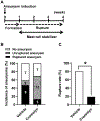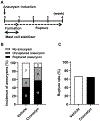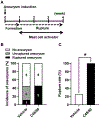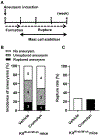Mast Cell Promotes the Development of Intracranial Aneurysm Rupture
- PMID: 33019897
- PMCID: PMC7606717
- DOI: 10.1161/STROKEAHA.120.030834
Mast Cell Promotes the Development of Intracranial Aneurysm Rupture
Abstract
Background and purpose: Inflammation has emerged as a key component of the pathophysiology of intracranial aneurysms. Mast cells have been detected in human intracranial aneurysm tissues, and their presence was associated with intramural microhemorrhage and wall degeneration. We hypothesized that mast cells play a critical role in the development of aneurysmal rupture, and that mast cells can be used as a therapeutic target for the prevention of aneurysm rupture.
Methods: Intracranial aneurysms were induced in adult mice using a combination of induced systemic hypertension and a single injection of elastase into the cerebrospinal fluid. Aneurysm formation and rupture were assessed over 3 weeks. Roles of mast cells were assessed using a mast cell stabilizer (cromolyn), a mast cell activator (C48/80), and mice that are genetically lacking mature mast cells (KitW-sh/W-sh mice).
Results: Pharmacological stabilization of mast cells with cromolyn markedly decreased the rupture rate of aneurysms (80% versus 19%, n=10 versus n =16) without affecting the aneurysm formation. The activation of mast cells with C48/80 significantly increased the rupture rate of aneurysms (25% versus 100%, n=4 versus n=5) without affecting the overall rate of aneurysm formation. Furthermore, the genetic deficiency of mast cells significantly prevented aneurysm rupture (80% versus 25%, n=10 versus n=8, wild-type versus KitW-sh/W-sh mice).
Conclusions: These results suggest that mast cells play a key role in promoting aneurysm rupture but not formation. Stabilizers of mast cells may have a potential therapeutic value in preventing intracranial aneurysm rupture in patients.
Keywords: intracranial aneurysm; mast cells; mice; subarachnoid hemorrhage; tryptase.
Figures






Similar articles
-
Human Mesenchymal Stem Cell-Derived Microvesicles Prevent the Rupture of Intracranial Aneurysm in Part by Suppression of Mast Cell Activation via a PGE2-Dependent Mechanism.Stem Cells. 2016 Dec;34(12):2943-2955. doi: 10.1002/stem.2448. Epub 2016 Jul 8. Stem Cells. 2016. PMID: 27350036 Free PMC article.
-
Pharmacological stabilization of intracranial aneurysms in mice: a feasibility study.Stroke. 2012 Sep;43(9):2450-6. doi: 10.1161/STROKEAHA.112.659821. Epub 2012 Jul 12. Stroke. 2012. PMID: 22798328 Free PMC article.
-
Prevention Effect of Antiplatelets on Aneurysm Rupture in a Mouse Intracranial Aneurysm Model.Cerebrovasc Dis. 2018;45(3-4):180-186. doi: 10.1159/000487812. Epub 2018 Apr 3. Cerebrovasc Dis. 2018. PMID: 29614486
-
Potential role of aspirin in the prevention of aneurysmal subarachnoid hemorrhage.Cerebrovasc Dis. 2015;39(5-6):332-42. doi: 10.1159/000381137. Epub 2015 May 7. Cerebrovasc Dis. 2015. PMID: 25967073 Free PMC article. Review.
-
TNF-alpha-mediated inflammation in cerebral aneurysms: a potential link to growth and rupture.Vasc Health Risk Manag. 2008;4(4):805-17. doi: 10.2147/vhrm.s2700. Vasc Health Risk Manag. 2008. PMID: 19065997 Free PMC article. Review.
Cited by
-
Integrated Transcriptional Profiling Analysis and Immune-Related Risk Model Construction for Intracranial Aneurysm Rupture.Front Neurosci. 2021 Apr 1;15:613329. doi: 10.3389/fnins.2021.613329. eCollection 2021. Front Neurosci. 2021. PMID: 33867914 Free PMC article.
-
Association of Interleukin-6 Signaling and C-Reactive Protein With Intracranial Aneurysm: A Mendelian Randomization and Genetic Correlation Study.Front Genet. 2021 Jun 8;12:679363. doi: 10.3389/fgene.2021.679363. eCollection 2021. Front Genet. 2021. PMID: 34168680 Free PMC article.
-
Endovascular Biopsy of Vertebrobasilar Aneurysm in Patient With Polyarteritis Nodosa.Front Neurol. 2021 Nov 23;12:697105. doi: 10.3389/fneur.2021.697105. eCollection 2021. Front Neurol. 2021. PMID: 34887823 Free PMC article.
-
Transcriptome-Based Dissection of Intracranial Aneurysms Unveils an "Immuno-Thermal" Microenvironment and Defines a Pathological Feature-Derived Gene Signature for Risk Estimation.Front Immunol. 2022 May 31;13:878195. doi: 10.3389/fimmu.2022.878195. eCollection 2022. Front Immunol. 2022. PMID: 35711443 Free PMC article.
-
Identifying pyroptosis- and inflammation-related genes in intracranial aneurysms based on bioinformatics analysis.Biol Res. 2023 Sep 27;56(1):50. doi: 10.1186/s40659-023-00464-z. Biol Res. 2023. PMID: 37752552 Free PMC article.
References
-
- Bederson JB, Awad IA, Wiebers DO, Piepgras D, Haley EC Jr., Brott T, Hademenos G, Chyatte D, Rosenwasser R, Caroselli. Recommendations for the management of patients with unruptured intracranial aneurysms: A statement for healthcare professionals from the stroke council of the american heart association. Stroke. 2000;31:2742–2750 - PubMed
-
- Zacharia BE, Ducruet AF, Hickman ZL, Grobelny BT, Badjatia N, Mayer SA, Berman MF, Solomon RA, Connolly ES Jr. Technological advances in the management of unruptured intracranial aneurysms fail to improve outcome in new york state. Stroke. 2011;42:2844–2849 - PubMed
-
- Frosen J, Tulamo R, Paetau A, Laaksamo E, Korja M, Laakso A, Niemela M, Hernesniemi J. Saccular intracranial aneurysm: Pathology and mechanisms. Acta Neuropathol. 2012;123:773–786 - PubMed
Publication types
MeSH terms
Substances
Grants and funding
LinkOut - more resources
Full Text Sources
Medical

